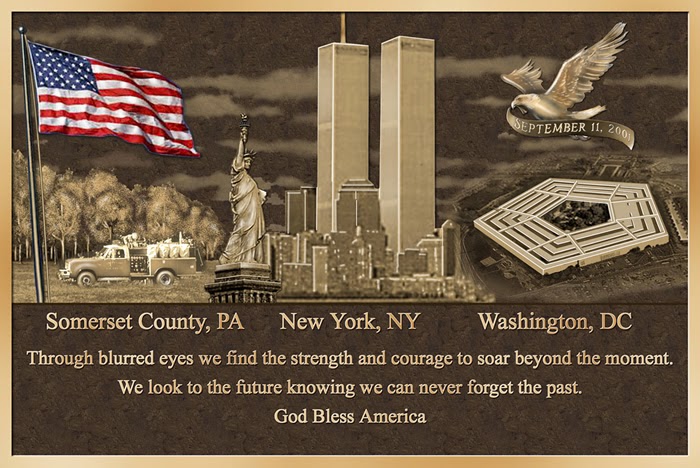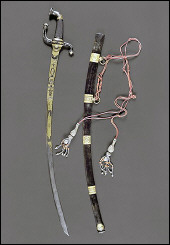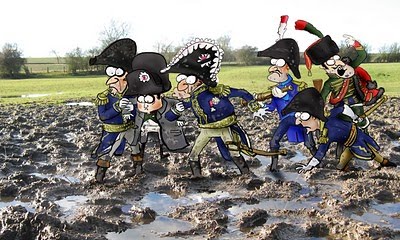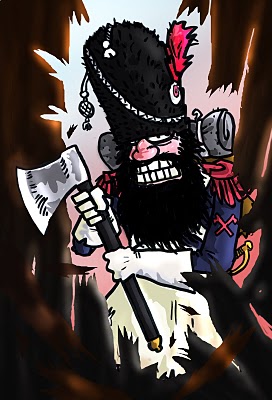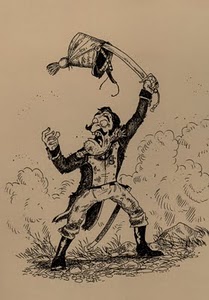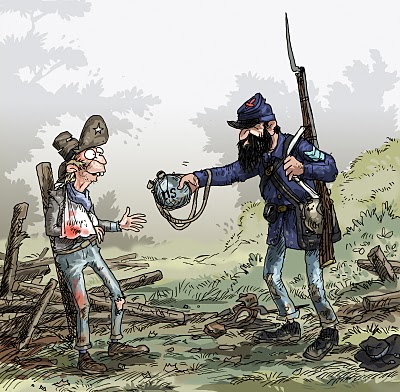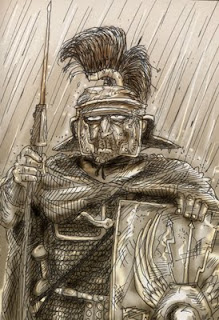We had our monthly game this past weekend. Jim ran a "Check Your Six" WWI airplane game that was very enjoyable. Jim had set up 3 scenario's of which we were able to run 2 within 4 hours (we decided to break at this point so everyone could handle family obligations).
The year was 1917 during the 3rd Battle of Ypres (July 21st until November 18th)
The first scenario had Mark and I playing allies. I had 2 Belgian Hanriot HD-1 fighter aircraft and 1 Belgian Sopwith 1 1/2 Strutter Observation plane. Mark had 2 British Sopwith Pups and one 1 British Sopwith 1 1/2 Strutter Observation plane. Our mission was to locate a large French infantry formation that had gotten trapped/lost behind enemy lines. I don't remember if this was identified as a battalion or anything. Jim placed 4 random makers on the table to mark the locations our Strutters were to search for this missing Frogs. Given my usual luck with pilots I rolled for all three of mine to be zero skill, I believe Mark may have had 1 skill level 1 pilot. The Germans had slightly better pilots over all. Greg and Jim each commanded 2 Albatross D-III aircraft. The aircraft Mark and I commanded only had one forward firing machine gun vs. two on the Albatross D-IIIs. The amount of damage that the German's could inflict with hits was significantly higher as a result.
Below is a photo of one of my Hanriots, nice bright blue target isn't it?
We got off to a fast start, my Strutter found the Frenchmen at the first counter area I searched. Now the challenge was to get the observer off the board so this information could be relayed to higher command. So I did something that wasn't very clever I flew my fighters one direction and the spotter the other. Suddenly it seemed the Sopwith was going to be overwhelmed.
It was about this time that one of Mark's pups went down in flames. The next photos show that and some general shots of the table. One of the photos shows two of the Albatross D-IIIs bee lining toward my Sopwith seen in the background. The final photos in this series shows one of my Hanriots being shot down the next turn by the same pilot (Jim) that had just shot Mark down.






My hero! Mark saves my bacon by hitting both of the German's who were intent on shooting me down. While neither were shot down both had critical hits placed on them that forced them both to break off pursuit and allowed my Sopwith to escape and deliver the valuable location of the lost troops. The last photo shows my lone remaining fighter showing up too late to accomplish anything other than looking pretty in blue. Both of the damaged German pilots were able to save both aircraft (and themselves). This would be important in Jim's new WWI air campaign he is running at Gigabytes Café and Games on the third Saturday of the month (I believe).
One win for the Allies.
Second game: Mark and I took the Germans for the second game. The allies consisted of two commands each with 2 Hanriots and one Sopwith Strutter. We did not know their objective and were considered on patrol. This time I rolled one of my pilots as a plus 2 skill level, of course my other was a zero. Everyone else had a mixture of skill levels, I seem to remember that both Mark and Jim each had a skill level 2 pilot also. As the location marker from the first game was still on the table we were brilliant in figuring out that the allied objective must have something to do with it. Almost immediately the 2 Sopwiths were able to successfully drop supplies to the cut off French. I was able to hit Jim's Sopwith and put damage on it but not force it down. Both of the Strutters then turned for a second run to drop more supplies. The last photos show the general "fur ball" going on and the last photos are of my skill level 2 pilot putting the hurt on one of Greg's. The second supply drop was half successful. Greg was able to drop his supplies on target while the damage to Jim's caused to him miss the drop zone and he provided the Germans with the supplies. Perhaps Cognac? It was determined that 3 out of 4 successful supply drops gave the allies a second victory on the day.








More to follow shortly.
We all enjoyed the games. The third scenario that we did not run would have been on with the allies making air to ground attacks on German positions to allow the cut off infantry make it back to their lines. Perhaps that will show up at a later game. Almost all of the aircraft used were from Shapeways and all were from Jim's and Mark's collections. Shapeways make a huge range of very nice aircraft for WWI.
The rules were great fun, while not as simple as the basic Wings of War they are still simple enough and have some nice chrome. I hate to say realistic touches as these are toys but the chrome that is in the game can be rooted in "realism". Ok, the logic used in the rules makes sense to us!
Our next game will be a 28mm WWII France 1940 game. The French are actually launching a limited counter attack against the Germans. These are skirmish type rules where everyone can command at least a platoon or so. They have been put together by Jim and we have had at least 2 previous games with these rules and we have enjoyed them. For me that says a lot as I am normally not much on skirmish games. This game is scheduled at our normal 2nd Saturday of the month for July 13th.
